Module 1 - Introduction to Matter, Energy, and Direct Current
Pages i,
1-1,
1-11,
1-21,
1-31,
1-41,
1-51,
1-61,
2-1,
2-11,
2-21,
3-1,
3-11,
3-21,
3-31,
3-41,
3-51,
3-61,
3-71,
3-81,
3-91,
3-101,
3-111,
3-121, Appendix
I,
II,
III,
IV,
V,
Index
Given:

Solution (a):
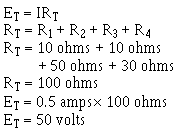
Solution (b):
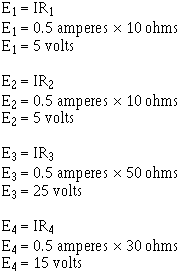
Solution (c):
3-31
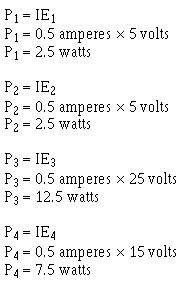
Solution (d):
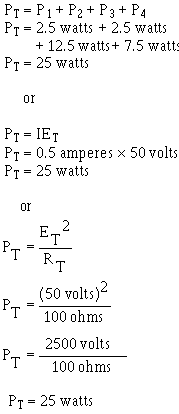
An important fact to keep in mind when applying Ohm's law to a series circuit is to consider whether the
values used are component values or total values. When the information available enables the use Ohm's law to find
total resistance, total voltage, and total current, total values must be inserted into the formula. To find total
resistance:
3-31

To find total voltage:

To find total current:

Note: IT is equal to I in a series circuit. However, the distinction between IT and I in the
formula should be noted. The reason for this is that future circuits may have several currents, and it will be necessary
to differentiate between IT and other currents.
To compute any quantity (E, I, R, or P) associated
with a single given resistor, the values used in the formula must be obtained from that particular resistor. For
example, to find the value an unknown resistance, the voltage across and the current through that particular resistor
must be used.
To find the value a resistor:

To find the voltage drop across a resistor:

To find current through a resistor:

Q21. a series circuit consists two resistors in series. R1 = 25 ohms and R2 = 30 ohms.
The circuit current is 6 amps. What is the (a) source voltage, (b) voltage dropped by each resistor, (c) total power,
and (d) power used by each resistor?
Kirchhoff's Voltage LAW
In 1847, G. R. Kirchhoff extended the use Ohm's law by developing a simple concept concerning the voltages
contained in a series circuit loop. Kirchhoff's voltage law states:
"The algebraic sum the voltage drops
in any closed path in a circuit and the electromotive forces in that path is equal to zero."
3-33
To state Kirchhoff's law another way, the voltage drops and voltage sources in a circuit are equal at
any given moment in time. If the voltage sources are assumed to have one sign (positive or negative) at that instant
and the voltage drops are assumed to have the opposite sign, the result adding the voltage sources and voltage drops
will be zero.
Note: The terms electromotive force and EMF are used when explaining Kirchhoff's law because
Kirchhoff's law is used in alternating current circuits (covered in Module 2). In applying Kirchhoff's law to direct
current circuits, the terms electromotive force and EMF apply to voltage sources such as batteries or power supplies.
Through the use Kirchhoff's law, circuit problems can be solved which would be difficult, and ten impossible,
with knowledge Ohm's law alone. When Kirchhoff's law is properly applied, an equation can be set up for a closed
loop and the unknown circuit values can be calculated.
POLARITY Voltage
To apply
Kirchhoff's voltage law, the meaning voltage polarity must be understood.
In the circuit shown in figure
3-22, the current is shown flowing in a counterclockwise direction. Notice that the end resistor R1, into which
the current flows, is marked Negative ( - ). The end R1 at which the current leaves is marked Positive (+). These
polarity markings are used to show that the end Ri into which the current flows is at a higher negative potential
than the end the resistor at which the current leaves. Point a is more negative than point B.
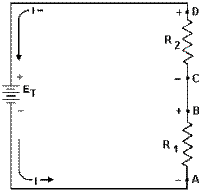
Figure 3-22. - Voltage polarities.
Point C, which is at the same potential as point B, is labeled negative. This is to indicate that point
C is more negative than point D. To say a point is positive (or negative) without stating what the polarity is based
upon has no meaning. In working with Kirchhoff's law, positive and negative polarities are
assigned in the direction
current flow.
3-34
APPLICATION of Kirchhoff's Voltage LAW
Kirchhoff's voltage law can be written
as an equation, as shown below: Ea + Eb + Ec + . . . En = 0 where Ea, Eb, etc., are the voltage
drops or emf's around any closed circuit loop. To set up the equation for an actual circuit, the following procedure
is used.
1. Assume a direction current through the circuit. (The correct direction is desirable
but not necessary.)
2. Using the assumed direction current, assign polarities to all resistors
through which the current flows.
3. Place the correct polarities on any sources included in
the circuit.
4. Starting at any point in the circuit, trace around the circuit, writing down
the amount and polarity the voltage across each component in succession. The polarity used is the sign AFTER the
assumed current has passed through the component. Stop when the point at which the trace was started is reached.
5. Place these voltages, with their polarities, into the equation and solve for the desired quantity.
Example: Three resistors are connected across a 5O-volt source. What is the voltage across the third resistor if
the voltage drops across the first two resistors are 25 volts and 15 volts?
Solution: First, a diagram,
such as the one shown in figure 3-23, is drawn. Next, a direction current is assumed (as shown). Using this current,
the polarity markings are placed at each end each resistor and also on the terminals the source. Starting at point
A, trace around the circuit in the direction current flow, recording the voltage and polarity each component. Starting
at point a and using the components from the circuit:

Substituting values from the circuit:
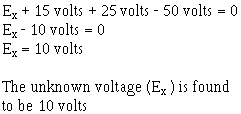
3-35
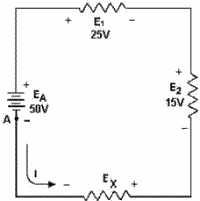
Figure 3-23. - Determining unknown voltage in a series circuit.
Using the same idea as above, you can solve a problem in which the current is the unknown quantity.
Example: a circuit having a source voltage 60 volts contains three resistors 5 ohms, 10 ohms, and 15 ohms. Find
the circuit current.
Solution: Draw and label the circuit (fig. 3-24). Establish a direction current flow
and assign polarities. Next, starting at any point - point a will be used in this example - write out the loop equation.
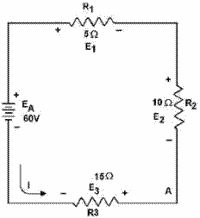
Figure 3-24. - Correct direction assumed current.
3-36

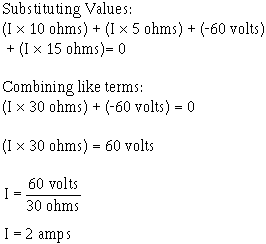
Since the current obtained in the above calculations is a positive 2 amps, the assumed direction current
was correct. To show what happens if the incorrect direction current is assumed, the problem will be solved as before,
but with the opposite direction current. The circuit is redrawn showing the new direction current and new polarities
in figure 3-25. Starting at point a the loop equation is:

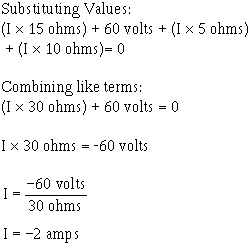
3-37
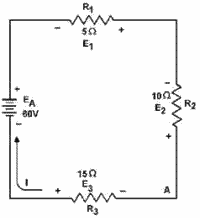
Figure 3-25. - Incorrect direction assumed current.
Notice that the AMOUNT current is the same as before. The polarity, however, is Negative. The negative
polarity simply indicates the wrong direction current was assumed. Should it be necessary to use this current in
further calculations on the circuit using Kirchhoff's law, the negative polarity should be retained in the calculations.
Series Aiding and Opposing Sources
In many practical applications a circuit may
contain more than one source emf. Sources emf that cause current to flow in the same direction are considered to
be Series AIDING and the voltages are added. Sources emf that would tend to force current in opposite directions
are said to be Series Opposing, and the effective source voltage is the difference between the opposing voltages.
When two opposing sources are inserted into a circuit current flow would be in a direction determined by the larger
source. Examples series aiding and opposing sources are shown in figure 3-26.
3-38
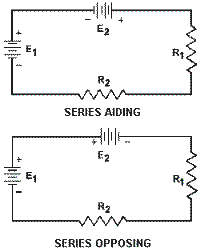
Figure 3-26. - Aiding and opposing sources.
A simple solution may be obtained for a multiple-source circuit through the use Kirchhoff's voltage
law. In applying this method, the same procedure is used for the multiple-source circuit as was used above for the
single-source circuit. This is demonstrated by the following example.
Example: Using Kirchhoff's voltage
equation, find the amount current in the circuit shown in fig 3-27.
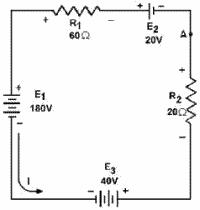
Figure 3-27.-Solving for circuit current using Kirchhoff's voltage equation.
3-39
Solution: As before, a direction current flow is assumed and polarity signs are placed on the
drawing. The loop equation will be started at point A.
E2 + ER1 + E 1 + E3 + ER2 = 0
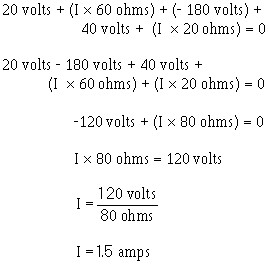
Q22. When using Kirchhoff's voltage law, how are voltage polarities assigned to the voltage drops
across resistors?
Q23. Refer to figure 3-27, if R1 was changed to a 40-ohm resistor, what would
be the value circuit current (IT)?
Q24. Refer to figure 3-27. What is the effective source voltage
the circuit using the 40-ohm resistor?
Circuit TERMS and Characteristics
Before you learn about the types circuits other than the series circuit, you should become familiar with
some the terms and characteristics used in electrical circuits. These terms and characteristics will be used throughout
your study electricity and electronics.
REFERENCE Point
A reference point is an
arbitrarily chosen point to which all other points in the circuit are compared. In series circuits, any point can
be chosen as a reference and the electrical potential at all other points can be determined in reference to that
point. In figure 3-28 point a shall be considered the reference point. Each series resistor in the illustrated circuit
is equal value. The applied voltage is equally distributed across each resistor. The potential at point B is 25
volts more positive than at point A. Points C and D are 50 volts and 75 volts more positive than point a respectively.
3-40
| - |
Matter, Energy,
and Direct Current |
| - |
Alternating Current and Transformers |
| - |
Circuit Protection, Control, and Measurement |
| - |
Electrical Conductors, Wiring Techniques,
and Schematic Reading |
| - |
Generators and Motors |
| - |
Electronic Emission, Tubes, and Power Supplies |
| - |
Solid-State Devices and Power Supplies |
| - |
Amplifiers |
| - |
Wave-Generation and Wave-Shaping Circuits |
| - |
Wave Propagation, Transmission Lines, and
Antennas |
| - |
Microwave Principles |
| - |
Modulation Principles |
| - |
Introduction to Number Systems and Logic Circuits |
| - |
- Introduction to Microelectronics |
| - |
Principles of Synchros, Servos, and Gyros |
| - |
Introduction to Test Equipment |
| - |
Radio-Frequency Communications Principles |
| - |
Radar Principles |
| - |
The Technician's Handbook, Master Glossary |
| - |
Test Methods and Practices |
| - |
Introduction to Digital Computers |
| - |
Magnetic Recording |
| - |
Introduction to Fiber Optics |
| Note: Navy Electricity and Electronics Training
Series (NEETS) content is U.S. Navy property in the public domain. |

























